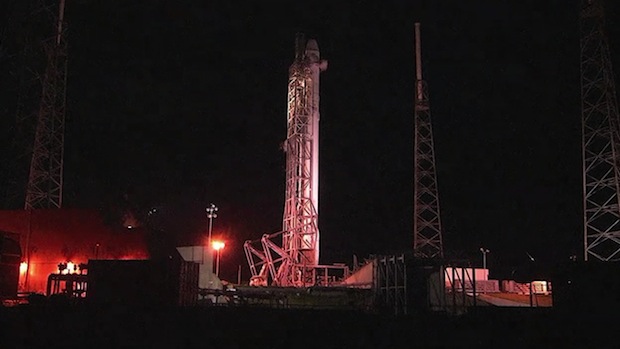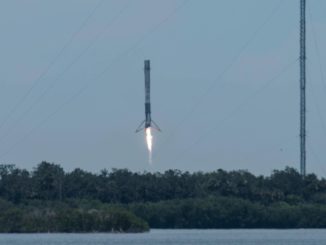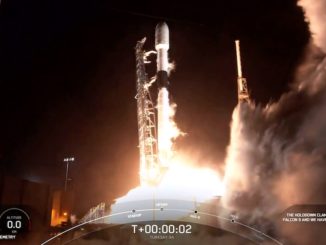STORY WRITTEN FOR CBS NEWS “SPACE PLACE” & USED WITH PERMISSION

Launch of a SpaceX Falcon 9 rocket carrying a Dragon cargo ship loaded with more than 5,100 pounds of equipment and supplies bound for the International Space Station was called off Tuesday less than two minutes before liftoff because of apparent problems with the second stage engine steering system.
Trouble with a second stage actuator assembly apparently cropped up last month during or in the wake of a first-stage engine test firing, sources said. The test firing was cut short, presumably because of a problem with the first stage propulsion system. SpaceX, in keeping with company policy, did not provide any details.
In any case, launch eventually was delayed three weeks to allow time for a second test firing, to give the SpaceX launch team a break for the Christmas holidays and to allow temperature constraints related to the station’s orbit to improve.
Sources said the suspect actuator assembly, one of two used to move the second stage engine nozzle for steering, was examined and given a clean bill of health. The Falcon 9’s first- and second-stage systems performed normally during the second countdown and test firing, setting the stage for Tuesday’s launch try.
A SpaceX spokesman said Tuesday, after the abort, that he could not address the engine test firing issue or provide any details about the second-stage steering system actuator. A senior SpaceX manager, asked about the test firing problem during a news conference Monday, did not provide any additional details other than saying the issue, whatever it was, had been resolved.
In a brief statement Tuesday, the company spokesman said only that during the terminal countdown “engineers observed drift on one of the two thrust vector actuators on the second stage that would likely have caused an automatic abort. Engineers called a hold in order to take a closer look.”
Company founder Elon Musk said in a Twitter posting: “Need to investigate the upper stage Z actuator. Was behaving strangely. Next launch attempt on Friday.”
Launch preparations went smoothly early Tuesday and the countdown ticked cleanly through fueling operations toward a planned liftoff at 6:20 a.m. (GMT-5). There were no known technical problems and the weather cooperated with fair conditions.
Then at T-minus one minute and 21 seconds, a SpaceX controller called a hold on the countdown audio net. To reach the space station, the rocket had to launch almost directly into the plane of the lab’s orbit, an “instantaneous” launch window that left no margin for delay.
As a result, the flight was postponed to Friday at the earliest, at 5:09:40 a.m. EST (GMT-5), the next available launch opportunity at the Cape Canaveral Air Force Station. Assuming the rocket gets off, the Dragon capsule will reach the station on Saturday shortly before 6 a.m.
“If this abort had not been called by the launch team, it would have triggered an abort automatically,” said NASA launch commentator George Diller. “The understanding at this early point is that the thrust vector control system actuators had a drift which would not have permitted an acceptable liftoff today as far as the second stage. The first stage appears to have performed nominally and was ready for launch.
“So right now, the team is preparing to de-tank the rocket. The launch team is still looking at the vehicle data to get better resolution of the issue..
The flight is the fifth for SpaceX under a $1.6 billion commercial contract with NASA calling for 12 missions to deliver more than 20 tons of supplies and equipment to the space station. And it is the first NASA-sponsored resupply flight since an Orbital Sciences Antares booster exploded seconds after liftoff Oct. 28, destroying a Cygnus cargo ship loaded with station supplies.
While the station typically maintains a four- to six-month supply of food and other consumables, “we’re definitely looking forward to the cargo that SpaceX 5 will be bringing up to us,” station flight engineer Terry Virts told a reporter in a post-abort space-to-ground interview Tuesday.
“Personally, we all have food and some Christmas presents on there that we’re looking forward to,” he said. “But more importantly there’s some good science and some equipment that we’ll need for future spacewalks on there. So, it’s an important resupply mission just like they’re all very important.”
Station commander Barry “Butch” Wilmore said he was looking forward to the Dragon’s arrival for more personal reasons.
“I’ll be honest, when you come up here your tastes change a little bit, a lot of people probably don’t know that, but you like spicy food,” he said. “We ran out of condiments about a month and a half ago, so I’m looking forward to getting some yellow mustard to make this food just a little more tasty!”
While cargo delivery is the primary goal of the Dragon mission, SpaceX also will attempt to land the Falcon 9 first stage on a barge stationed 200 miles off the coast of Jacksonville, Fla., a major milestone in Musk’s drive to lower launch costs by re-flying booster hardware that otherwise would be discarded in the ocean.
Virts said a successful landing would be “pretty amazing.”
“The real benefit there is an economic one, if you can reuse the boosters I think that’s going to reduce the cost of launching to space, which of course is important,” he said. “It’s the biggest limiting factor we have in getting to space. So if they’re successful being able to reuse the first stage booster, that’ll definitely help.”
But the thrust vector control problem is a wild card and it was not immediately known what it might take to resolve the issue or whether SpaceX will be able to clear the rocket in time for another launch try Friday.



